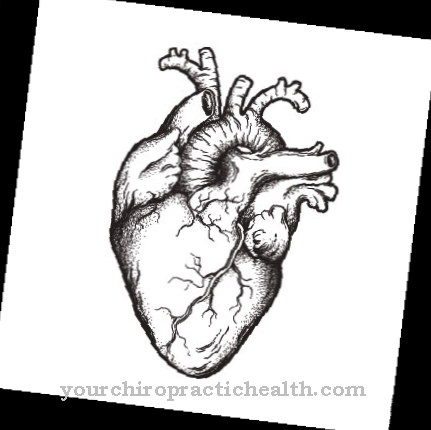As Tinea corporis is a fungal infection of the skin on the body, including the extremities without the hands and feet. The infection occurs through filamentous fungi and is symptomatically accompanied by reddening of the skin or pustules with severe itching. More than 30 types of filamentous fungus are known to cause tinea corporis in humans.
What is tinea corporis?

© RandomizeTH - stock.adobe.com
Tinea corporis is a fungal disease of the skin of the body, which also includes the extremities without hands and feet. Localized reddening of the skin or even pustules filled with tissue fluid or pus are symptomatic. The infected areas of the skin typically cause severe itching.
Tinea corporis is one of the most common skin diseases that can take a mild or acute course depending on the pathogen and the nature of the immune system. In many cases, the infection is chronic and the symptoms are mild. Skin fungi, also called dermatophytes, live aerobically and heterotrophically, which means that their metabolism is dependent on oxygen and organic substances for nutrition.
A common characteristic of skin fungi is their ability to break down and metabolize keratin from dead skin cells. They have the enzyme keratinase, which in principle also enables other proteins such as collagen and elastin to be broken down. Dermatophytes, which can be infectious for humans, can be divided into anthropophilic, zoophilic and geophilic pathogens according to their “preferences”.
While the anthropophilic species specialize in infecting human skin, the zoophilic species infect animals, including domestic animals. However, zoophilic dermatophytes can also affect humans. The geophilic species occur almost everywhere in the soil and are only pathological to humans in exceptional cases.
causes
Tinea corporis is caused by pathogenic filamentous fungi, which are counted among the skin fungi or dermatophytes. More than 30 types of thread fungi are known that can lead to typical fungal infections in human skin. Since pathogenic skin fungi or their spores are almost ubiquitous, an infection that leads to the development of tinea corporis is favored by a weakened immune system.
For example, diabetes mellitus, an immune system weakened by HIV or artificially suppressed by drugs to suppress rejection reactions, represent increased risk factors. The disease can be transmitted through direct skin contact or through contact with shared objects such as towels or washcloths and through surfaces in the sanitary area.
Public sauna areas or swimming pools are also frequent sources of infection, since the skin fungi prefer warmth and moisture. Infections are therefore particularly persistent in areas of the body that are usually warm and moist, for example between the toes. An infection with zoophilic dermatophytes can also occur through direct physical contact with infected pets, such as dogs, cats or hamsters.
Symptoms, ailments & signs
Symptomatic of tinea corporis are small, round spots on the skin with a diameter of one to two centimeters. Characteristic, but not mandatory, is an emphasis on the edges of the spots and an itchy sensation that can be severe. In the case of deeper infections, inflammation symptoms can also appear.
In the case of infections with anthropophilic dermatophytes adapted to humans, the symptoms that occur are usually weak, so that they are often hardly noticed and a chronic fungal skin disease can develop due to non-treatment. Deeper fungal infections can also be accompanied by painful inflammatory reactions.
A special form is the so-called tinea corporis gladiatorum, also known as mat burn, which mainly affects martial arts athletes who practice their sport on floor mats and who can get smaller abrasions when thrown or fall on the mat, into which certain thread fungi penetrate and trigger the mat burn.
Diagnosis & course of disease
The typical symptoms, including itching, that seem to indicate tinea corporis can be caused by other causes such as psoriasis, dry eczema, and others. In order to rule out any confusion, a smear of the affected skin area is examined under a light microscope.
If it becomes necessary to identify the exact type of filamentous fungus, a culture with the smear of the skin can be created on various nutrient media. However, the procedure can take several weeks to complete. An examination using Wood light, also known as black light, can also provide information.
The black light in the UV range with a wavelength of up to 365 nanometers causes areas of the skin that are infected with certain dermatophytes to glow green-yellow. A genetic examination of the fungal DNA to precisely identify the type of fungus is also possible.
Complications
If left untreated, tinea corporis can cause a number of severe skin irritations. There is severe pain, itching and redness, which those affected find extremely uncomfortable. Occasionally bleeding occurs. In addition, painful blisters and pustules form over the course of the process, which can become inflamed. As the process progresses, the fungal infection spreads to other regions of the body.
The result is scales, papules and sometimes painful abscesses. Tinea corporis can also have psychological effects in the long term. Sick people often suffer from inferiority complexes and depressive moods. Treatment with antimycotics can cause side effects such as nausea, vomiting or headache. Fever and chills as well as kidney and liver damage can occur in rare cases.
In pregnant women and mothers who are breastfeeding, the preparation can harm the child. In addition, allergies or intolerances may occur that require further treatment. Even improperly used home and natural remedies can cause discomfort and under certain circumstances make tinea corporis worse. It is therefore advisable to discuss the treatment of a fungal infection of the skin with your family doctor or a specialist beforehand.
When should you go to the doctor?
With tinea corporis, the affected person is in any case dependent on a medical examination and treatment. This is the only way to prevent further worsening of the symptoms, and further complications can arise if the disease is not treated. Therefore, with tinea corporis, a doctor should be contacted as soon as the first symptoms or complaints appear. As a rule, self-healing cannot occur with this disease.
In the case of tinea corporis, the doctor should be consulted if the person concerned suffers from severe itching of the skin. In most cases, the skin is covered with spots, which can also lead to infection or inflammation on the skin itself. If these symptoms occur, the person concerned must definitely consult a doctor. As a rule, tinea corporis also leads to a significant reduction in aesthetics, which can also lead to psychological upsets or depression. In this case, a psychologist should be consulted. The symptoms of tinea corporis are treated by a dermatologist.
Treatment & Therapy
In principle, topical and systemic and a combination of both types of therapy are available for the treatment of tinea corporis. Topical therapy involves the local treatment of the fungal infection with antifungal creams or ointments, tinctures or powders. Most antimycotics aim to inhibit ergosterol, which is an important and necessary component of the cell membranes of the fungi.
If topical treatment does not work because many parts of the body are affected, systemic treatment through the oral intake of certain drugs with antifungal agents is also possible. However, interactions with other drugs and possible side effects must be considered. In principle, therapies should be continued three to four weeks after the symptoms have subsided in order to avoid a flare-up of the fungal infection (relapse).
prevention
The most important prevention to avoid tinea corporis is an intact immune system. If the immune system cannot work optimally due to other diseases or due to artificial immunosuppression or due to unfavorable living conditions, typical sources of infection such as public baths and saunas should only be entered with flip-flops and thoroughly dried off after showering. Breathable clothing is also a preventative measure. Towels and textiles should be washed at 90 degrees to safely kill any fungi and spores.
Aftercare
In most cases of tinea corporis, those affected have only limited or very few direct follow-up measures available. For this reason, the person affected should consult a doctor at an early stage to prevent other complications and complaints from occurring. It is also not possible to heal independently, so that a doctor should be consulted at the first signs and symptoms of the disease.
Most sufferers usually need to take various medications to relieve or limit the symptoms. Care should always be taken to ensure that it is taken regularly and that the dosage is correct. If anything is unclear or questions arise, a doctor must always be consulted first.
The doctor should also be contacted if there are changes or discomfort on the skin. The life expectancy of the person concerned is usually not reduced. In some cases, contact with other patients with the disease can also be useful, as this leads to an exchange of information.
You can do that yourself
In addition to drug treatment, those affected can use other simple home remedies to help: The main priority here is to keep the infected skin areas dry in order to prevent the fungus from spreading. In addition to sufficient air supply for the skin, infected areas can be powdered with healing earth or baking powder. However, due to the additional care substances and oils contained, conventional cosmetic powders and baby powders are not recommended here.
Apple cider vinegar has long been used as an old remedy for fungal infections. Those affected can dab the affected areas several times a day with a cotton ball soaked in apple cider vinegar. Tea tree oil and Australian manuka honey are used in a similar way. Like apple cider vinegar, these products are also said to have an antifungal, i.e. fungicidal effect. However, all these funds should not be used if an antifungal ointment is applied to the skin at the same time.
Again and again, moist, warm compresses that have previously been soaked in sage or chamomile stock are recommended as home remedies. The extracts from sage and chamomile are said to have a disinfectant and fungicidal effect. However, since the dark, moist environment under the compress provides ideal growth conditions for mushrooms, other forms of self-therapy should be used.




.jpg)



















.jpg)



